2020 Annual Report for: Erebidae / Herminiinae
For species seen in 2020 that had less than or equal to 100 records, full details are included; for more common species, the earliest, latest and highest count by vice-county are shown. The narrative for each species is taken from the main Hantsmoths website, and it is possible that some information on abundance and occurrence can get out of date, as it is impossible to keep up with all changes; however it should give a good introduction to each species. The tables in each species account summarise the previous status, and that for the current year.
For the maps, all records prior to 2020 are shown by a blue dot (the larger the dot, the more recent), with the current year's records shown in red. As previous records are superimposed on any report for 2020, new sites have greater emphasis (i.e. will show as 'more red').
In the species accounts, an asterisk next to a location indicates a new 10km square record; earliest ever dates are highlighted in orange, and latest ever in red. Initials in the species accounts refer to the recorders listed here. Please get in touch if you identify any omissions or errors, in particular if you have records that have yet to be submitted. Details of how to submit records can be found here.
72.052 [B&F: 2493] Dotted Fan-foot Macrochilo cribrumalis (Hübner, 1793) - Nb
Principally found in the east of the country from Norfolk to Kent, with recent evidence of an expansion westward in central and southern England. In Hampshire a colony in Emer Bog persisted for many years and may still remain, although there have been no reports since 1993. In recent years, particularly since 2020, it has been recorded annually from scattered localities across the county. Not recorded from the Isle of Wight to date. Wingspan 27-30 mm. Larva feeds on Hairy Wood-rush, Field Wood-rush and Sedge in fens, marshes, bogs and ditches, although there has been no direct evidence of breeding in our area.
Records prior to 2020
| Vice County | #Records | #Individuals | First Record | Last Record |
|---|---|---|---|---|
| 11 | 13 | 7 | 1900 | 2019 |
| 12 | 3 | 3 | 2006 | 2017 |
2020 records
| Vice County | #Records | #Individuals | Max Quantity |
|---|---|---|---|
| 11 | 1 | 1 | 1 |
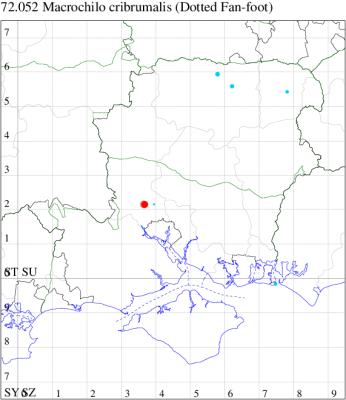
Records by year
Records by week (adult)
Records by week (larval)
Record Details
VC11: Romsey, one, 24 Jun (SLay)
72.053 [B&F: 2489] Fan-foot Herminia tarsipennalis Treitschke, 1835 - Common
Common in broad-leaved woodland, hedgerows and gardens throughout the British Isles. Widespread and common in Hampshire and on the Isle of Wight. Wingspan 31-33 mm. The most likely confusion species is Common Fan-foot Pechipogo strigilata, a rare and declining species, despite the name, which is paler and less deeply coloured, with fainter, less well-defined cross-lines; by comparison Z. tarsipennalis is a rich, deep brown, with dark, almost black, cross-lines. The current species is often mis-reported as the 'common' fan-foot, so please take care on record entry.
Also possibly confused with Small Fan-foot Herminia grisealis, from which told by the median line being dead straight in Small Fan-foot and the subterminal line curving towards the apex (wing-tip). In Fan-foot, this is the opposite - the median line is curved, whereas the subterminal line is straight. See the comparison image in the collection above for an comparative illustration of the two species together.
Larva feeds on the withered leaves of various deciduous trees and shrubs, including Beech and Oak.
Records prior to 2020
| Vice County | #Records | #Individuals | First Record | Last Record |
|---|---|---|---|---|
| 10 | 407 | 767 | 1951 | 2019 |
| 11 | 3391 | 4844 | 1951 | 2019 |
| 12 | 1361 | 2538 | 1951 | 2019 |
2020 records
| Vice County | #Records | #Individuals | Max Quantity |
|---|---|---|---|
| 10 | 27 | 44 | 4 |
| 11 | 94 | 136 | 6 |
| 12 | 49 | 85 | 7 |
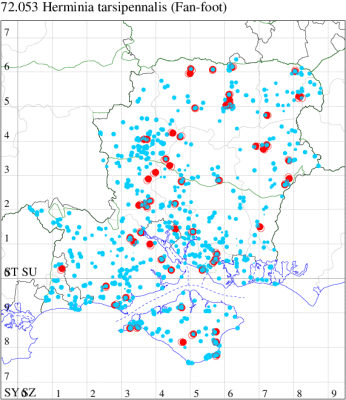
Records by year
Records by week (adult)
Records by week (larval)
Record Summary
VC10: Earliest: West High Down Quarry, 07 Aug, 4 (IOu) Latest: Borthwood Copse, Winford, 23 Jun, 1 (IOu) Max count: West High Down Quarry, 07 Aug, 4 (IOu)
VC11: Earliest: Brockwood, 04 Jul, 1 (SDut) Latest: Pennington, 23 Jul, 1 (RFC) Max count: Marchwood, 24 Jun, 6 (CTh)
VC12: Earliest: Cholderton, 17 Jul, 1 (TJN, HE) Latest: Yateley, 23 Jun, 3 (JHH) Max count: Basingstoke, 24 Jun, 7 (MJW)
72.055 [B&F: 2492] Small Fan-foot Herminia grisealis ([Denis & Schiffermüller], 1775) - Common
Common in broad-leaved woodland, scrub, hedgerows and gardens throughout the British Isles. Widespread and common in Hampshire and on the Isle of Wight. Wingspan 22-28 mm. Differs from Fan-foot Zanclognatha tarsipennalis, and all other fan-foots, by having the median line being dead straight and the subterminal line curving towards the apex. In Fan-foot, this is the opposite - the median line is curved, whereas the subterminal line is straight. See the comparison image in the collection above for an comparative illustration of the two species together.
Larva feeds on the withered leaves of various deciduous trees and shrubs, including Pedunculate Oak, Downy Birch, Alder, Hazel, Hawthorn and Bird Cherry, over-wintering as a pupa.
Records prior to 2020
| Vice County | #Records | #Individuals | First Record | Last Record |
|---|---|---|---|---|
| 10 | 405 | 1058 | 1856 | 2019 |
| 11 | 2073 | 2348 | 1951 | 2019 |
| 12 | 825 | 971 | 1951 | 2019 |
2020 records
| Vice County | #Records | #Individuals | Max Quantity |
|---|---|---|---|
| 10 | 16 | 24 | 4 |
| 11 | 18 | 19 | 2 |
| 12 | 6 | 7 | 2 |
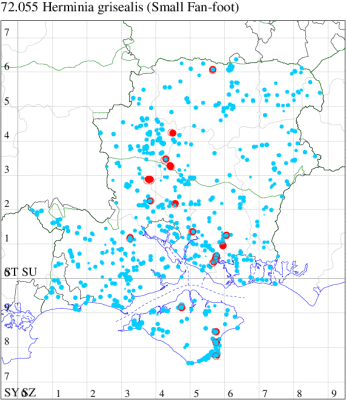
Records by year
Records by week (adult)
Records by week (larval)
Record Details
VC10: Parkhurst Forest, two, 29 Jun (IOu); Bonchurch, one, 07 Jun; one, 08 Jun; one, 11 Jun; two, 15 Jun; one, 17 Jun; one, 19 Jun; four, 24 Jun; two, 25 Jun; one, 12 Jul (JHa); Shanklin, two, 25 Jun; two, 01 Jul; one, 22 Jul; one, 17 Aug; one, 18 Aug; Borthwood Copse, Winford, one, 23 Jun (IOu);
VC11: Woodlands, New Forest, present, 13 Jun (RBW); Kings Somborne, one, to actinic, 11 Jun (GCE); Romsey, one, 09 Jun (NRJ); Kings Somborne, two, to actinic, 09 Jul (GCE); Allbrook, one, 24 Jun (SI); Fareham, one, 15 Jun (ADT); one, 16 Jun (IMcP); one, to actinic, 11 Jun (MLO); Wickham, one, 07 Aug (F.M.G.); Botley, one, to actinic, 24 Jun (SLB); Wickham, one, 19 Jun; one, 23 Jun; two, 28 Jun; one, 29 Jun; one, 10 Jul; one, 23 Jul (JRDS); West Walk, one, 14 Aug (F.M.G.);
VC12: Anna Valley, Andover, one, 23 Jun (TJN); Crawley, one, 25 Jun (TNo); one, to actinic, 30 Jun; two, to actinic, 30 Jun; Barton Stacey, one, to actinic, 25 Jun (GCE); Axmansford, one, 04 Jul (ACB)
72.056 [B&F: 2488] Common Fan-foot Pechipogo strigilata (Linnaeus, 1758) - Nationally Rare
Nationally scarce (Na) in ancient deciduous woodland in parts of southern England, a priority species under the UK Biodiversity Action Plan. Still found in a few localities in its previous range which included most of England south of the Humber and parts of Wales. In Hampshire its decline mirrored the national trend and until recently was only reliably found in Pamber Forest, but in recent years has been found to have a relatively strong population in the Harewood Forest area. The only modern record from the Isle of Wight was a strong count of 22 in Parkhurst Forest in June 1988: it is therefore rather mystifying why it hasn't been reported from there since. Wingspan 32-34 mm. The most likely confusion species is the rare immigrant Jubilee Fan-foot Zanclognatha lunalis, which see for differences. Larva feeds on Pedunculate Oak.
Records prior to 2020
| Vice County | #Records | #Individuals | First Record | Last Record |
|---|---|---|---|---|
| 10 | 5 | 0 | 1856 | 1988 |
| 11 | 49 | 230 | 1800 | 2011 |
| 12 | 116 | 420 | 1900 | 2019 |
2020 records
| Vice County | #Records | #Individuals | Max Quantity |
|---|---|---|---|
| 11 | 2 | 3 | 2 |
| 12 | 2 | 2 | 1 |
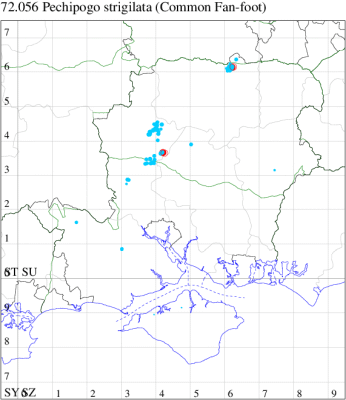
Records by year
Records by week (adult)
Records by week (larval)
Record Details
VC11: Shirrell Heath, two, 24 Jun (LEdg); Pilley Bailey, NF*, one, 07 Jul (RBW, MWa);
VC12: Chilbolton, one, to actinic, 16 Jun (GCE); Pamber Forest, one, 15 Jun (GJD)
72.057 [B&F: 2488a] Plumed Fan-foot Pechipogo plumigeralis (Hübner, [1825]) - Recent colonist
Formerly a rare immigrant from mainland Europe, appearing in south-eastern England for the first time at Greatstone, Kent, in October 1995, with about a dozen subsequent records, mostly between Dungeness and Rye Harbour in subsequent years. First reported in our area at Southsea in 2006, but since 2011 has been recorded annually in the south-east of the Isle of Wight and the Portsmouth / Hayling area of Hampshire and is now locally established as a breeding species in our area, as it is in other coastal counties in southern and eastern England, where it can be relatively common. Wingspan 22-26 mm. Larva feeds on Broom and Ivy.
Records prior to 2020
| Vice County | #Records | #Individuals | First Record | Last Record |
|---|---|---|---|---|
| 10 | 13 | 16 | 2013 | 2019 |
| 11 | 12 | 11 | 2006 | 2019 |
2020 records
| Vice County | #Records | #Individuals | Max Quantity |
|---|---|---|---|
| 10 | 7 | 8 | 2 |
| 11 | 4 | 2 | 1 |
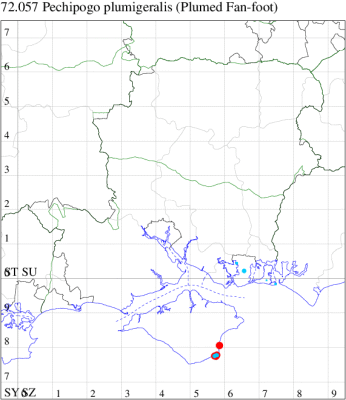
Records by year
Records by week (adult)
Records by week (larval)
Record Details
VC10: Wheelers Bay, one, 01 Aug; one, 06 Aug (ABu); two, 08 Aug (IOu); Bonchurch, one, 15 Jul; one, 07 Aug; one, 11 Aug (JHa); Shanklin Upper Chine*, one, 08 Aug (IOu);
VC11: Gosport, one, to actinic, 12 Aug (HGre); Northney, Hayling Island*, present, 23 Jun; present, 06 Aug (JWP)
(2020)()().jpg)

(To UV Bulb)().jpg)